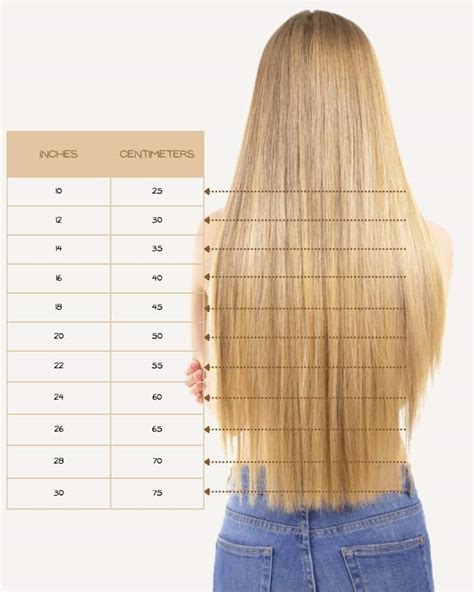Are you curious about the length of your hair? Or perhaps you’re planning a haircut and want to be precise with your instructions? Whatever your reason, our comprehensive Hair Inch Chart will provide you with accurate measurements and valuable insights.

How to Measure Hair Length
Step 1: Prepare Your Hair
- Wash and condition your hair as usual.
- Remove any tangles or knots using a wide-toothed comb or detangling brush.
- Part your hair down the middle, creating a straight line from the forehead to the nape of the neck.
Step 2: Use a Measuring Tape or Ruler
- Hold the measuring tape or ruler at the part where you want to start measuring.
- Flatten the hair against your head and measure from the root to the tip, following the natural curve of your hair.
- For shoulder-length hair or longer, measure from the crown of your head.
Step 3: Convert Inches to Centimeters
- If necessary, convert inches to centimeters by multiplying the number of inches by 2.54.
Hair Inch Chart
| Length | Inches | Centimeters |
|---|---|---|
| Very Short | 0-2 | 0-5 |
| Short | 2-4 | 5-10 |
| Bob | 4-8 | 10-20 |
| Shoulder-Length | 8-12 | 20-30 |
| Mid-Back Length | 12-16 | 30-40 |
| Waist-Length | 16-20 | 40-50 |
| Hip-Length | 20-24 | 50-60 |
| Classic Length | 24-28 | 60-70 |
| Floor-Length | 28+ | 70+ |
Why Hair Length Matters
- Appearance: Your hair’s length can dramatically alter your overall appearance, allowing you to express your personality and style.
- Hair Care: The length of your hair determines the frequency and type of hair care you need. For example, longer hair requires more regular trims and deep conditioning treatments.
- Heat Damage: Longer hair is more prone to heat damage from styling tools, so it’s essential to take precautions to protect it.
- Extensions and Wigs: If you’re considering hair extensions or wigs, knowing your hair’s length is essential to determine the right fit and appearance.
Benefits of Measuring Hair Length
- Accurate Haircuts: Measuring your hair length before getting a haircut ensures you receive the desired style.
- Hair Growth Tracking: Tracking your hair length over time can indicate its growth rate and help you assess the effectiveness of hair care products.
- Product Selection: Knowing your hair’s length can help you choose the right hair care products for your needs, such as shampoos, conditioners, and styling aids.
- Planning Hairstyles: Knowing your hair’s length can inspire you to create different hairstyles and experiment with new looks.
Tips and Tricks
- Use a flexible measuring tape or ruler to follow the natural curve of your hair accurately.
- Measure your hair when it’s dry and styled as usual to get a realistic measurement.
- If you’re measuring hair that’s been layered or cut unevenly, take multiple measurements at different sections and average them out.
- Consider using a hair growth tracker app to monitor your hair’s length over time.
Key Considerations
- Hair Density: Hair density can affect the appearance of length. Thicker hair may appear shorter than thinner hair of the same length.
- Hair Texture: Curly or wavy hair may appear shorter when dry and straightened.
- Hair Damage: Damaged hair may appear shorter due to breakage.
- Shrinkage: Natural hair types may shrink when wet, so consider measuring dry hair.
Interesting Fact: The average hair growth rate is approximately 0.5 inches per month, or 6 inches per year.
Conclusion
Our Hair Inch Chart provides a comprehensive guide to measuring hair length accurately. Understanding your hair’s length is crucial for maintaining its health, achieving desired hairstyles, and making informed decisions about hair care products and treatments. Embrace the power of hair measurement and unlock a world of possibilities for your locks!
